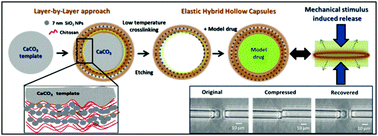Mechanical stimuli responsive and highly elastic biopolymer/nanoparticle hybrid microcapsules for controlled release†
Abstract
Mechanical stimulus is one of the universally accessible physical ways of triggering the drug release from their carriers. Hollow microcapsules made of polyelectrolyte multilayers by conventional methods are not elastic enough to respond to a large and repetitive mechanical deformation. Here, hybrid hollow capsules comprising alternating layers of inorganic colloidal particles and biopolymers were prepared by the layer-by-layer approach followed by freezing-assisted crosslinking of polymer layers. The size of the capsule was controllable by the size of sacrificial cores. These hybrid capsules were mechanically more stable and recover faster than polyelectrolyte capsules, and could be recovered elastically even after large and repetitive deformation up to 98% relative to their original dimensions. Drugs in a wide range of molecular weight up to 70 kDa Mw could be loaded into the hollow hybrid microcapsules and the release of loaded contents from these hybrid capsules could be controlled through the deformation by applying a weak force such as a finger pressing on them. Mechanical stimuli-responsive delivery of model drugs was demonstrated on a monolayer of these hybrid capsules.



 Please wait while we load your content...
Please wait while we load your content...